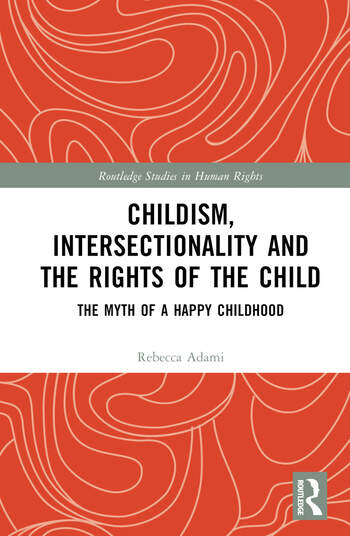Interview with Rebecca Adami about her book, Childism, Intersectionality and the Rights of the Child
Our member, Dr. Rebecca Adami (Stockholm University, Sweden), talks about her new book, Childism, Intersectionality and the Rights of the Child: The Myth of a Happy Childhood (Routledge, 2024).

Q: What is this book about?
Children constitute more than a third of the world’s population and ‘children’ as a heterogenous group consists of all other marginalised groups. Nonetheless, theorizations on the limits of social justice generally do not recognise children’s additional marginalisation through age-based power structures.
Against this backdrop, Childism, Intersectionality and the Rights of the Child offers a critical human rights theory of age-based discrimination and prejudice against children. It addresses questions that seem to have been largely overlooked on how injustice against children, as a heterogenous group, can be explored in relation to key UN international human rights conventions. Additionally, it provides insights on how to analyse violations against children through the intersections of racism, sexism, and ableism.
This theory contributes to the field of human rights studies by critically exploring human rights issues during childhood through intersectionality by adding the layer of childism—age-based prejudice and discrimination against children—to racist, sexist and ableist forms of oppression.
In this work, I identify discursive and structural obstacles to the realisation of children’s human rights. I focus on obstacles arising from intersections of racism and childism, intersections of sexism and childism, and intersections of ableism and childism.
The book thus provides a much-needed theorization for addressing violations against human rights during childhood. This theorization brings to light tensions between childism, on the one hand, and notions of equality and non-discrimination of children, on the other. With this work, I introduce the reader to a new vocabulary connected to age-based discrimination against children.
Q: What made you write this book?
The rights of the child can be seen as one of the weakest chains in the international human rights framework. There is a wide range of titles on critical human rights theory but here children seem to be treated as a sub-category where the adult is the norm. Similarly, studies of prejudice generally do not include the notion of age-based discrimination against children.
In the UN history of international human rights, children’s rights have been treated separately from the mainstream human rights literature. Although the UN Convention on the Rights of the Child (CRC) has become the most widely ratified UN treaty on human rights, empirically based research into children’s rights highlights its weak implementation.
Literature on human rights studies, which critically theorises these issues, has become increasingly important in the interdisciplinary study of children’s human rights. Within the Routledge Studies on Human Rights book series, this is the first monograph specifically dealing with critical child rights theory. Human rights theory is a vast field that recognises children’s rights as part of human rights, and the emphasis has finally shifted from finding justifications for why children should be granted rights to explorations on how their rights can be realised in child-equitable ways.
An excerpt from the book (pages 28-29):
Critical child rights theory on power, discrimination and epistemic injustice can be employed by professionals working with children’s rights to better understand how the subject positions available to children become incapacious in discourses characterized by racism, sexism, ableism and childism. Incapacious subject positions in discourses reified by power in turn limits children’s room for action and agency.
Critical theory on intersectionality helps problematize how the uniqueness of a child’s identity is not expressed freely under discriminatory stereotyping of ‘children’. Intersectionality is used in this book to question the ways in which policy on children’s rights that informs praxis might treat ‘children’ as a homogenous group that overlooks discrimination and privilege but also how prejudiced categorizations of children in dominating societal discourses makes it hard for a child to take subject positions other than the stereotyping available. Children need to challenge negative expectations held about them on a daily basis if not to succumb to internalizing self-degrading prejudice.
To employ the use of childism and intersectionality in child rights studies is to hold what some might regard as two seemingly opposing thoughts simultaneously: to explicate discourses that limit children while at the same time acknowledging that children have agency to question and challenge these discourses in different ways. It has been claimed that the use of critical theory in child rights studies reifies inequality through its focus on the nonideal situations of child abuses (discussed further in chapter two), but I argue that it is the dominating discourses on racism, sexism, ableism and childism that fortifies intersectional inequality and discrimination against children.
Critical theory is used to question, reflect on and ultimately change such oppressive societal discourses. Children are thus not ‘turned into passive victims’ when oppression and abuse is revealed as structural problems through the notion of childism, on the contrary, when termed as political and social problems the discursive practices of discrimination can be addressed through politics, law and change of social beliefs. The rights of the child and human rights are normative claims in themselves.
The idea of social equality is normative. That does not prevent a critical examination of rights and ideas of equality whereby questions raised throughout the book (left without simplified answers) aim to create a reflective space over taken for granted problem formulations in a normative field.